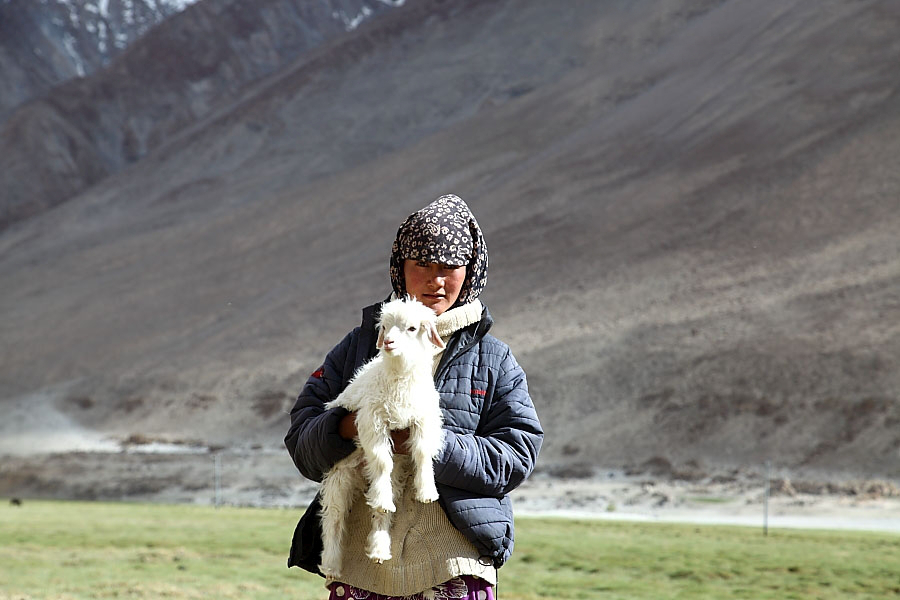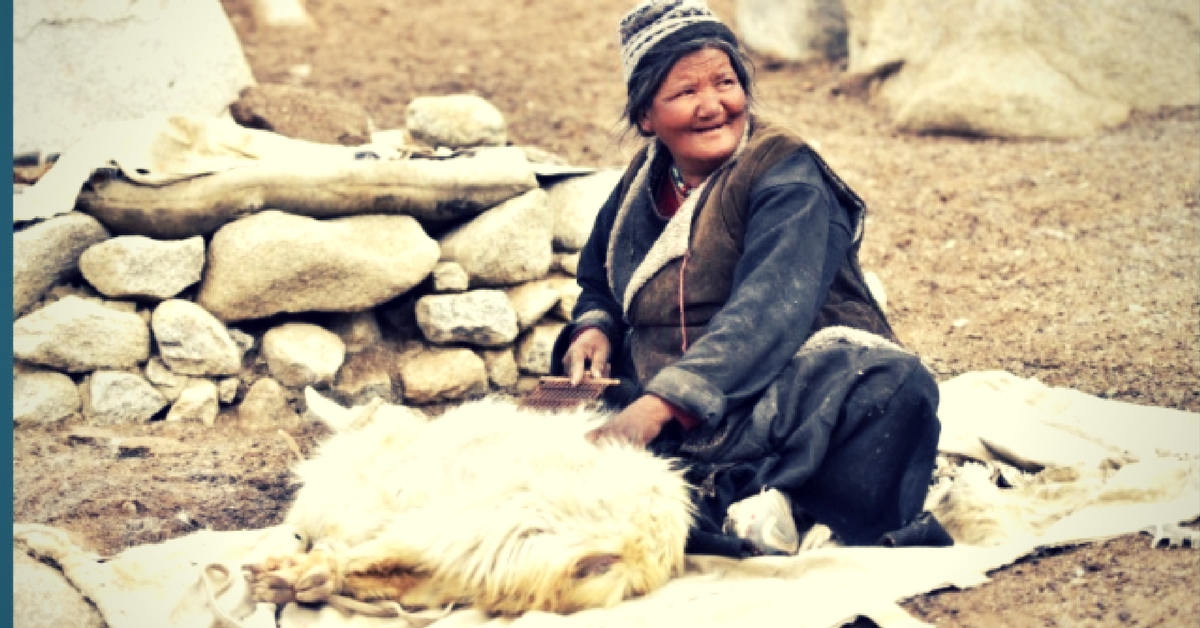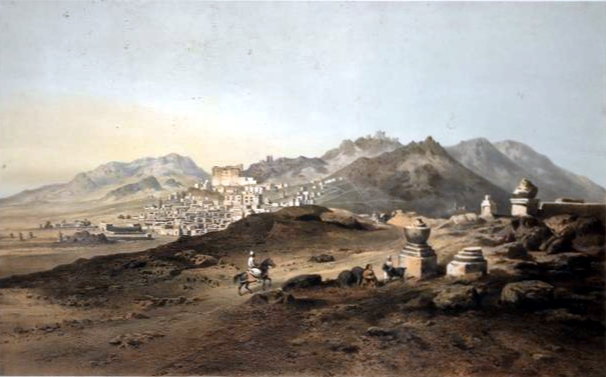What You Probably Didn’t Know About Ladakh’s History With the Pashmina
Right from the Mughal era, Ladakh’s fate has been deeply interwoven with Pashmina.

For centuries, the region of Ladakh, particularly Leh, was an important stopover along international trade routes—from Mongolia, China and Tibet in the east to Kashmir, Central Asia, and Europe in the West.
Salt, grain, pashmina or cashmere wool, charas or cannabis resin from the Tarim Basin in northwest China, silk yarn, cotton and indigo were among the goods that traversed through these parts.
Pashmina stands out for its role in determining the economic fate of Ladakh and is deeply interwoven with its history. Kashmiri artisans, traders and merchants brought the attention of the world to this fine fabric with their exquisite finished products like shawls and other apparel.
The raw material for this fabric comes from the famous Changra goats which graze the high pastures of the Changthang region perched 14,000 feet above sea level in East-Southeast Ladakh, and the highlands of Western Tibet. These goats are reared by the Changpas, an agro-pastoralist community.

Although Pashmina has been deeply intertwined with the economic and political fortunes of Ladakh since many centuries, for the sake of brevity it is essential to begin in the 17th century. One can trace the contours of modern Ladakh, and the role played by the Pashmina trade, in the famous Treaty of Tingmosgang of 1684, a tripartite agreement between the then King of Ladakh, the Tibetan kingdom and the Mughals.
Although the Mughals during the reign of Aurangzeb were successful in protecting Ladakh from a Tibeto-Mongol invasion (the king of Ladakh had sought the help of the Mughals to repel the army), he had to comply with a tripartite agreement.
Signed in 1684, the treaty stated that all pashmina from Western Tibet would find its way through Ladakh, while Kashmiri traders would have exclusive rights to purchase pashmina from Ladakh.

With the disintegration of the Mughal Empire, Ladakh began to exercise a certain degree of independence, but the pashmina trade went along the contours of the original treaty. Everything changed in 1834, when the legendary Dogra general, Zorawar Singh, launched vicious military campaigns in the region driven by the desire to control the pashmina trade.
It was Zorawar Singh’s campaigns that effectively brought an end to any aspirations of an independent Ladakhi kingdom. The Dogras, one must note, were vassals of the Sikh Empire.
After suffering defeat at the hands of the Dogras, the then royal prince of Ladakh and his third wife escaped to a British protectorate and sought their assistance. Unfortunately, none was forthcoming because the East India Company had just fought brutal and expensive battles against the Gorkhas of Nepal, and did not fancy administering remote areas. More importantly, they had signed a treaty with the Sikhs in 1809, in which it was agreed that Punjab would stand as a bulwark against the Afghans, while the British would not interfere in affairs north of the Sutlej river.
However, it was the Treaty of Leh signed between the Tibetan kingdom and the Dogras in 1842, which officially marked the end of Ladakh’s independence. Under this treaty, the Tibetans recognised Dogra dominion over the region, while reaffirming previous trade arrangements.

Matters came to a head once again when the East India Company defeated the Sikh Empire in first Anglo-Sikh War in 1845-46. When the British won the war, the Dogras under Maharaja Gulab Singh switched sides, and they signed the Treaty of Amritsar with the British in 1846.
“According to the Treaty of Amritsar, signed in 1846, the British were to get a war indemnity of Rs 7.5 million and an annual payment of ‘one horse, twelve perfect shawl goats of approved breed (six males and six females) and three pairs of Cashmere shawls.’ With this treaty, the Dogra king could rule over “all the hilly or mountainous country, situation to the eastward of the river Indus and westward of river Ravee,” writes Ravina Aggarwal, a noted anthropologist, in her book “Beyond Lines of Control: Performance and Politics on the Disputed Borders of Ladakh, India.”
The Treaty of Amritsar began an era of Dogra allegiance, and in 1858, when the British monarchy formally took over India, all princely states agreed to its authority.
Read also: From Monk to Statesman: Here Is a Remarkable Indian You May Not Have Heard Of!
“Although they did not deem Ladakh economically viable for direct rule, the British pushed for control over regional trade with a commercial treaty that the Dogra Maharaja was made to sign in 1870. This accord facilitated the British access to lucrative raw pashmina and allowed them to establish the post of a British joint commissioner to be stationed in Leh for three months to monitor trade,” writes Aggarwal.
In addition to the control of pashmina trade, the Dogra kings imposed a series of economic measures that had a debilitating effect on the Ladakhi economy. Fast forward to 1948, and when Maharaja Hari Singh, the last Dogra king, signed the Instrument of Accession with India, it was the contours of the Treaty of Amritsar that was used to justify bringing Ladakh under the administrative control of the new state of Jammu and Kashmir.
Successive wars against Pakistan and China devastated economic opportunities in the region with trade links on either side of the border significantly diminished, leaving Ladakh with little to no chance at any real economic development until the advent of tourism in the 1970s.
Read also: How an IAS Initiative Is Weaving Pashmina’s Profits Back to Ladakhi Women
Once a critical stop along international trade routes, the livelihood for the people of Ladakh today stands on three pillars—the Indian Army, government jobs, and tourism.
There are efforts underway to revive the local economy with both the J&K government and Centre supporting a whole host of micro-small and medium enterprises. There are also local efforts underway to reclaim ownership of the pashmina trade with ventures moving into the production of finished products. With most of the value in pashmina locked higher up in the supply chain, the region has long deprived itself of economic benefits.
There is hope that pashmina can once again play a role in regenerating the local economy.
Like this story? Or have something to share? Write to us: [email protected], or connect with us on Facebook and Twitter.
NEW: Click here to get positive news on WhatsApp!
If you found our stories insightful, informative, or even just enjoyable, we invite you to consider making a voluntary payment to support the work we do at The Better India. Your contribution helps us continue producing quality content that educates, inspires, and drives positive change.
Choose one of the payment options below for your contribution-
By paying for the stories you value, you directly contribute to sustaining our efforts focused on making a difference in the world. Together, let’s ensure that impactful stories continue to be told and shared, enriching lives and communities alike.
Thank you for your support. Here are some frequently asked questions you might find helpful to know why you are contributing?


This story made me
-
97
-
121
-
89
-
167











